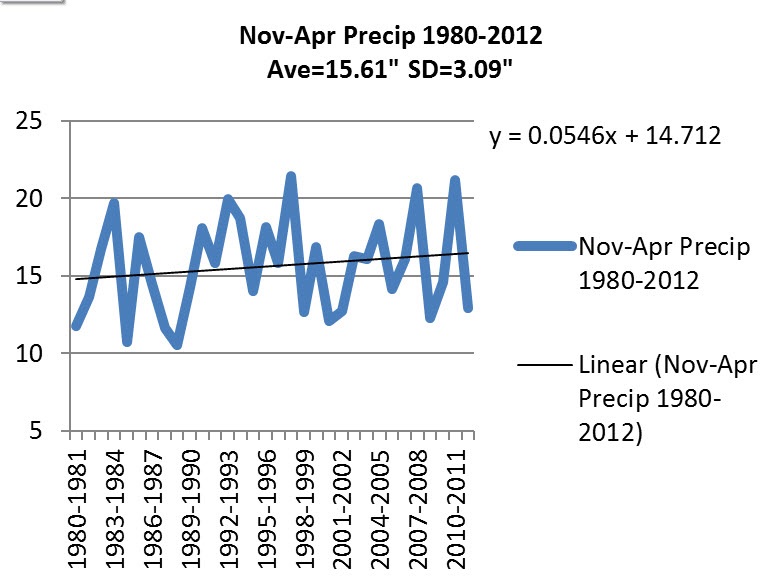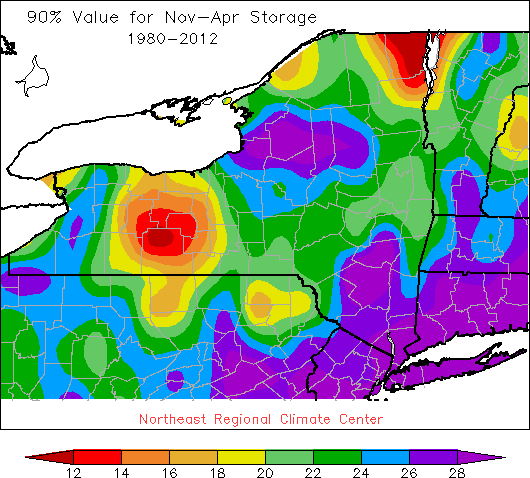![]() Waste to Worth home | More proceedings….
Waste to Worth home | More proceedings….
Abstract
Manure storage design and operation are influenced by climate and weather. The Northeast United States has been identified as likely to experience more frequent and larger precipitation events in climate change models. The Northeast Regional Climate Center (NRCC) predicts that particularly in New York and New England where the frequency of 2 inch rainfall events has increased since the 1950s and storms once considered a 1 in 100 year event have become more frequent. Such storms are now likely to occur almost twice as often. In consultation with Natural Resource Conservation Service (NRCS) the NRCC has put together a website www.precip.net that includes estimates of extreme rainfall for various durations (from 5 minutes to 10 days) and recurrence intervals (1 year to 500 years). Although the public website remains static, providing design criteria, updated data is continually collected. It is anticipated that this will show a continual shift in extreme rainfall amounts. Monthly and yearly rainfall also impact manure storage design. The impacts of both changing extreme rainfall and monthly rainfall amounts on manure storage design are explored. Higher freeboard amounts to protect from overtopping and more total storage to provide flexibility in abnormally wet weather are recommended to be incorporated in manure storage facility designs.

|
Why Are We Concerned About Climate Change Impacts on Manure Storage?
The need to increase the storage capacity of manure storages due to climate change is evaluated. Although the weather is variable, climate change appears to increase precipatation especially during the winter storage period. This increase in precipatation and the increased control of winter manure spreading puts farms with too little storage at greater risk. Although in general the 25 year 24 hour storm has not increased in NY, farms have experienced less storage than anticipated. The use of average precipitation amounts based on the full period of record doesn’t take into account above average precipitation during the storage period or recent increases in winter precipitation.
What Did We Do?
 |
Average winter precipatiation was determined in 3 periods of record, prior to 1950, 1950 to 1980, and 1980 to 2012 at five locations in NYS. This showed that the more recent period had an increased precipitation. This matches climate model predictions for increased winter precipitation in the northeast. The amount of winter precipitation that would not be exceeded 90% of the time was determined. Present design proceedures use the average precipitation for each month of winter storage. This means that 50% of the time a storage may experience more precipitation than designed. Maps were prepared to show the precipitation amounts that would not be exceeded 90% of the time for both 6 months and 8 month storage periods.
 |
What Have We Learned?
There are many reasons for manure storages to fill faster than design including; increased animal numbers, increased manure production, increased bedding or wash water, additional drainage area, and failure to empty prior to the storage period. Wetter weather than average and wet weather in the spring puts farms with storage at risk. The winter precipitation amount is increasing.. NYS farms with storage are experiencing stress during some seasons that then cause them to try to reduce the stress by spreading manure at times that can potentially pollute. Prudent manure storagedesign whould take this into account. Using updated and conservative precipitation amounts would increase the designed storage. This would increase the cost of the storage structures but allow farms to follow their Nutrient management plans more closely.
Future Plans
NY NRCS will change the precipitation amount used in the design of manure storages.
Authors
Peter Wright PE, State Conservation Engineer Natural Resources Conservation Service , Syracuse NY, peter.wright@ny.usda.gov
Jessica L. Rennells, Climatologist, Northeast Regional Climate Center, Cornell University
Arthur T. DeGaetano, Director Northeast Regional Climate Center, Cornell University
Curt Gooch P.E. , Senior Extension Associate, PRO-Dairy, Cornell University
Additional Information
https://www.usda.gov/oce/energy-and-environment/climate
http://ncadac.globalchange.gov/download/NCAJan11-2013-publicreviewdraft-chap2-climate.pdf
The authors are solely responsible for the content of these proceedings. The technical information does not necessarily reflect the official position of the sponsoring agencies or institutions represented by planning committee members, and inclusion and distribution herein does not constitute an endorsement of views expressed by the same. Printed materials included herein are not refereed publications. Citations should appear as follows. EXAMPLE: Authors. 2013. Title of presentation. Waste to Worth: Spreading Science and Solutions. Denver, CO. April 1-5, 2013. URL of this page. Accessed on: today’s date.

